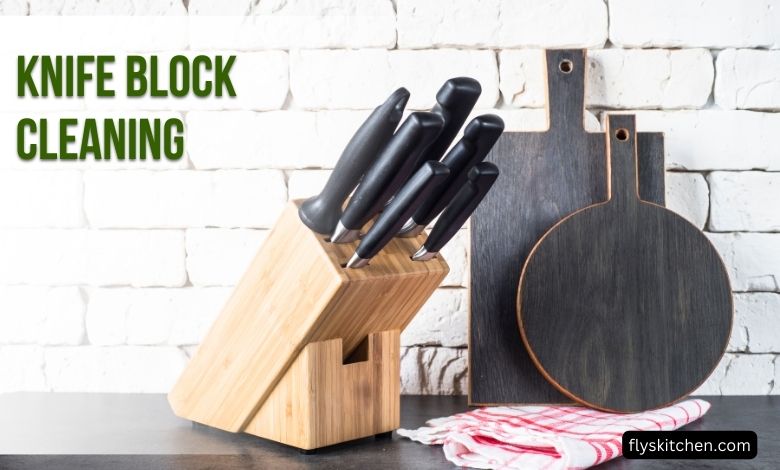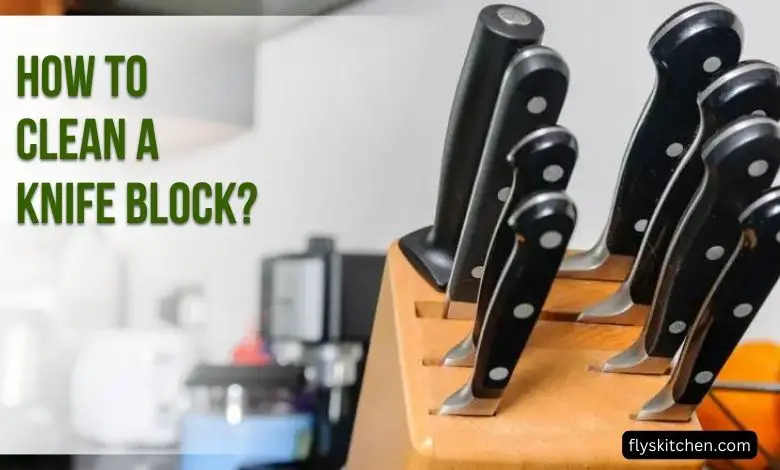A knife block is an essential part of any kitchen. It keeps your knives organized, sharp, and ready to use. However, like any other part of your kitchen, a knife block needs regular cleaning to keep it sanitary and functioning properly. Learning how to effectively clean your knife block will extend its life and keep your knives performing optimally.
Contents
Why Cleaning Your Knife Block Matters
While it’s out of sight on your countertop, a dirty knife block can harbor harmful bacteria. Food particles and cooking oils can get lodged in the slots and crevices. Without regular cleaning, bacteria from raw meats and poultry can even get transferred to your unused knives, leading to cross-contamination.
A clean knife block not only reduces bacteria but also keeps your blades sharper for longer. When debris builds up, it can dull your knife edges every time you remove or insert them from the block. Oils can also get sticky and cause blades to stick when sliding them in and out.
Proper cleaning also keeps all the moving parts of your knife block in good working order. From sliding mechanisms to blade guards and sharpening components, regular cleaning protects your investment and prevents issues like corrosion.
Supplies You’ll Need
Cleaning your knife block is a simple process, but you’ll need a few key supplies:
- Dish soap or mild detergent – Avoid anything too harsh that could damage finishes
- Warm water – Hot water can damage tempered steel blades
- Clean sponges & cloths
- Small brush for scrubbing crevices
- Compressed air (optional) – For drying
- Masking tape (optional) – To protect knife edges
You likely already have most of these supplies in your kitchen. It’s a good idea to use sponges and cloths designated just for cleaning to avoid spreading grease and germs from other parts of your kitchen.
Step-by-Step Knife Block Cleaning

Follow these steps for a thorough cleaning of your entire knife block:
1. Remove Knives and Accessories
Take everything out of the slots, including knives, shears, sharpening rods, and other accessories. This gives you full access to the entire block. Lay knives flat on a clean towel on the counter.
2. Wash Removable Parts
Many knife blocks have removable parts that come out for easy cleaning. The slots themselves often lift out. Wash these in warm, soapy water, using a brush to scrub away any grime that has built up. Rinse and dry completely.
3. Clean Slots and Crevices
Use a damp cloth to wipe down the inside of the empty block, including the slots. Pay special attention to crevices where gunk can collect. For stubborn areas, use a small brush and warm, soapy water.
4. Wash Knives and Accessories
Wash each knife and accessory by hand using hot water and dish soap. For extra protection, you can use masking tape to cover the edges. Avoid running the blades through the dishwasher, as this can damage them. Rinse and dry thoroughly.
5. Disinfect Entire Block
For a deeper clean, use a disinfectant on all parts of the block as well as your hand-washed knives and accessories. Spray or wipe on and let sit per product instructions before a final rinse. This will kill any remaining germs. Allow to fully air dry.
6. Oil and Sharpen Knives
Before putting your knives back in the block, do a final maintenance step. Use a honing steel to touch up the edges. You can also apply a mineral oil to protect stainless steel blades from corrosion. Avoid oiling wooden handles.
7. Return Items to Block
Once everything is dry, reinsert all your knives, shears, and accessories back in their designated slots. Make sure blades are pushed all the way in for optimal safety. Your block is now sparkling clean and organized!
How Often To Clean Your Knife Block
For moderate use, a thorough cleaning every 3-4 months is recommended. However, certain factors may require cleaning your knife block more frequently:
- Heavy use – Clean every 1-2 months
- Noticeable grime buildup – Clean immediately
- Used to cut raw meat – Disinfect after each use
- Humid environment – Clean more often to prevent mold
Get in a routine based on your habits and inspect your block periodically. It’s better to clean when you notice any dirtiness or sticky buildup rather than allow it to get out of hand.
Knife Block Cleaning Tips
- Soak removable parts in hot water and soap to loosen stuck-on debris and oils before scrubbing.
- Use a toothbrush, skewer, or chopstick to get in thin slots.
- Rinse your knife block with clean water after washing to remove residual soap before drying.
- Allow the block to fully air dry before putting the knives back to prevent moisture damage.
- Never put wooden knife blocks in the dishwasher or soak for long periods.
- Freshen worn blocks by sanding and re-oiling occasionally.
- Replace soiled slot dividers, brush guards, and other accessories.
FAQs
How do I clean inside a knife block?
Use warm, soapy water and a small brush to scrub inside the slots and crevices. Remove any removable parts and wash them separately before rinsing out the entire block.
Can I put a knife block in the dishwasher?
No, you should always handwash a knife block gently using mild soap and water. The harsh chemicals and heat can damage many knife blocks.
What’s the best way to clean wood knife blocks?
Dampen a soft cloth with a small amount of gentle detergent mixed with warm water. Gently wipe down the exterior surfaces only. Avoid submerging or soaking.
How can I sanitize my knife block?
Use a disinfectant spray or wipes registered by the EPA to kill germs. Spray liberally over all surfaces and let sit before rinsing and drying completely.
How often should I clean my knife block?
Aim to clean your knife block deeply every 3-4 months. Clean more frequently if you notice visible buildup or use it often for raw meats.
Conclusion
While it might seem tedious, regular knife block cleaning is essential for kitchen safety and the optimal performance of your knives. Follow these steps and tips to keep your block free of hazardous bacteria and working smoothly for years to come. Implement a cleaning routine based on your usage levels. With the proper care, your knife block can last decades and provide perfect storage for your cherished cutlery.

